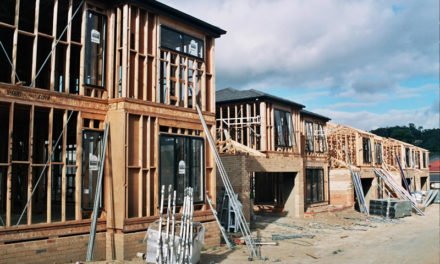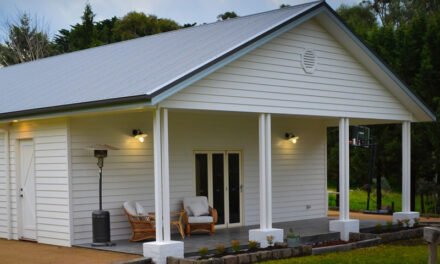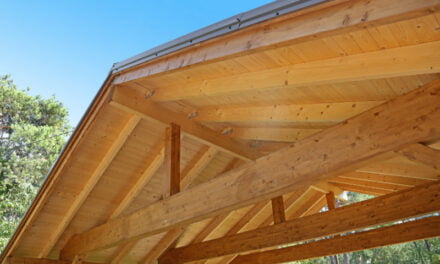When it comes to street appeal, nothing beats timber cladding, with performance qualities that equal its architectural adaptability.
Timber cladding is what you think of when you visualise a classic Australian home, whether it’s a suburban Queenslander or the Pritzker Architecture Prize-winning excellence of Glenn Murcutt’s designs. But it’s not just tradition that keeps us returning to this most versatile of materials, it’s the way timber is perfectly designed for our country’s varied conditions.
The natural flexibility of timber as a material stands up to our extremes of climate and country, whether they be high winds, driving rains, salt-laden winds, highly reactive soils, subsidence or even earth tremors. There are even commonly available timber claddings made from species rated to BAL 29 for bushfire danger, without additional treatment.
This ability to adapt to situations is echoed by timber’s ability to adapt to different architectural styles and trends, whether in profile, in finish, or even with a coating or colour finish. Able at once to look timeless and also completely of the moment, timber is the most versatile cladding material available, and that’s just the start of its benefits.
Fire-retardant
“It’s a common misconception that steel is better than timber from a fire-risk perspective,” says Michael Kennedy of Kennedy’s Timbers. His business supplies high-quality reclaimed and sustainable architectural timbers around Australia, with an emphasis on the Queensland market.
“Steel isn’t safer. In fires, if you use a timber that’s suited for BAL-29 areas – and there’s a number of those, including spotted gum and blackbutt, both Class 1 durability timbers – they will stand up to a fire better than steel, because steel will buckle and twist when it gets under heat.”
Steel’s propensity to twist and even melt under heats commonly reached in bushfires provides access for ember attacks into the structure of the house, heightening the risk of a catastrophic house fire. “Whereas timber will char,” Kennedy says. “In fact, there’s a Japanese method – Shou-Sugi-Ban, or Yakisugi – that actually chars timber, not to damage it but to preserve it.”
While Kennedy’s stocks a great many fire-resistant timbers, it doesn’t stock a charred cladding, but other suppliers in the Australian market do.
Eco Timber’s Charred Timber cladding is long-term maintenance free and colourfast – which makes perfect sense, since the colour is an integral part of the finished timber board. The charring process creates a carbon crust that is UV resistant, so won’t ‘silver’ or ‘grey’, as untreated timbers will.
The base timbers for Charred Cladding include red ironbark, Queensland spotted gum and blackbutt. There are two depths of char to choose from: ‘standard’, with its elegant black finish, or ‘deep’, with a crackled appearance and they are available as external boards, pre-oiled with Cutek CD50, or internal board, sealed with a matte water-based polyurethane to stop the carbon residue transferring.
Timber screens, battens, posts and so on can also be charred to order to complete the overall design, and custom profiles made.
The cladding requires a degree of finesse in its installation, with special black screws and Black Ash Cutek Timber Protection Oil used to seal cut ends and conceal any blemishes made during the installation process, but it’s a small price to pay for a product that not only looks as though it has stepped straight from an episode of Grand Designs, it also requires very little upkeep.
Recycled beauty
Of course, not everyone is enticed by the architectural equivalent of a little black dress. It is almost impossible, however, to imagine anyone not wooed by the tactile beauty of recycled timber. Strong and weathered, this wood comes with a back story that can add interest to any new build.
And recycled cladding can come from some unexpected places, Kennedy says: “We recut a lot of recycled timber. So the boards will come in bigger in sections – perhaps it was bridge timber, or from a wharf or a power pole. We’ll recut that, dry it and process it and run it into cladding.”
Timber is graded by finish when it arrives at Kennedy’s Timbers, so the customer can choose from finishes that are silky smooth to those that are rustic and textured. The most popular species for cladding are spotted gum, ironbark, blackbutt and tallowood. “They’re all class 1 durability species,” says Kennedy, “which are suitable for high exposure applications outside.”
While timber stands up admirably to the common Queensland threats of fire, flood and cyclone, there are smaller, more insidious enemies about, but Kennedy says the main cladding species they use are surprisingly unbothered by termites: “Even in Queensland, the termites will only eat them if there’s nothing else to eat. It’s a bit like brussels sprouts and me. I’ll eat them if there’s nothing else on the plate, but I’d rather eat the plate instead.
“They generally don’t require treatment, particularly the ironbark. For other species, if they’re going to be in contact with an area where termites could get to them, you would take measures. Your standard barriers will be enough,” he adds.
Profiles and combinations
Alongside the appearance of the timber, the other major factor in selecting a cladding is the profile of the cladding itself. The old-fashioned sawn weatherboard profile still has its adherents (and can be used very cleverly by a good designer), but most cladding in the marketplace today comes in one of the following three profiles: ship-lap, with its smooth overlapping arrangement; tongue and groove chamfer, with its tightly interlocked boards; or board and batten, with its geometric wave of battens standing proud of the boards.
Megan Para of Australian Sustainable Hardwoods (ASH), says, “Our IronAsh cladding is most popular in a shiplap profile for exterior cladding.”
IronAsh is one of the most reliably versatile timber claddings on the market. Treated to H3 classification (using transparent, water-based additives), it can be easily cut, stained or painted on site. The timber comes from sustainably grown coupes, but despite its high quality, it is an affordable product for clients who are keeping an eye on budgets.
For designs that focus on timber, IronAsh is perfectly matched to ASH’s main interior product. As Para says, “Our GoodWood Victorian Ash internal cladding includes regency VJ lining and a similar shiplap profile as IronAsh. This allows architects and home owners to match throughout a space, ensuring a continuous flow of design from inside to out.
“It all becomes part of the one organic look, your Victorian Ash stairs, your wall lining, screening, and then you walk outside and it’s the same timber.”
And for those not looking for a soothing consistency of finish in their building, IronAsh can also be adapted to provide a timber accent as part of a mixed façade.
“Often our cladding is mixed with other surface materials,” says Para. “We’ve seen it used alongside brick, for example. You don’t have to stick with one finish for the whole house, you can use contrasts – it is an incredibly versatile product to work with.”
In addition to contrasts of material, cladding can be applied in contrasting directions to create a sense of play in a façade or emphasise the directionality of the architecture.
Finishes and fixings
Like any natural product, the appearance of timber can change over time. As Kennedy says, “There is an increasing demand for natural products in building and natural finishes, so people are letting them grey. Because our timbers are so durable, you can let them grey and they’re going to last 25, up to 40 years as cladding, with you doing absolutely nothing to them.”
At ASH, most of their timber is supplied pre-coated. “Our cladding is typically given a clear coat for protection,” says Para. “Although there are some projects where the IronAsh cladding has been left to grey off. It all comes down to what look the architect and client are after. Customers have the option to leave it as is, or to stain it any colour they desire.”
Kennedy’s Timbers also offers pre-oiling for customers. Penetrating oils can be applied clear or with a tint. This style of product lowers the impact of punishing UV radiation without affecting the feel of the timber or giving it a ‘plasticky’ look.
For a little more sheen, transparent film coatings can be used. These usually have higher UV coverage and last two to five times as long as an oil, but are more complex to apply.
Oiling requires a degree of upkeep. Kennedy says, “We’ll often apply a pre-oiling, and then when it gets to site, they’ll re-apply oil. After that, you’d generally apply oil annually to keep that fresh timber colour.”
Cladding installed as directed by the manufacturer has a remarkably long lifespan, with basic maintenance.
“In terms of termites and decay, our IronAsh is an all rounder,” says Para. “We offer a 25-year warranty against insect attack and decay. Iron Ash cladding is suitable for any reputable exterior coatings to be applied.”
Fixings and installation details are sometimes overlooked by building designers, but provide an important part of the final look, from beads and window openings to the choice of non-corrosive nails and other fixings. Some, such as Eco Timber’s Blackheadz screws, are designed to disappear into the finished surface and it’s worth researching options.
Timber for health
While the range of cladding choices available extends far beyond the scope of this article and includes engineered timbers, plywood and compressed wood fibreboards, all deliver a superior result in terms of insulation, appearance and durability.
But there’s another factor that’s both more important and more ephemeral. Timber is simply better for people. “It’s true,” says Kennedy. “Not only does timber look better and store carbon, it’s actually healthier. Planet Ark put out their ‘Make It Wood: Do Your World Some Good’ report (makeitwood.org), and it talks about the benefits of using wood in buildings and what that does to the wellbeing of the occupants.”
The report outlined the psychological and physiological benefits of timber in buildings, which mimics the effect of spending time outside in nature. It found that offices that incorporate natural-looking timber finishes were strongly associated with increased employee wellbeing and satisfaction, an effect termed ‘biophilia’. Natural wooden surfaces led to employees reporting higher personal productivity, confidence, clarity, mood and optimism.
As Kennedy succinctly puts the case for timber surfaces: “We know, for example, if you put wood in an office building, you have fewer sick days from the employees in that building. Purely by putting in wood: doing nothing else. Now imagine how that could impact your life if that was also how you lived at home every day.”
For more information on cladding choices, visit www.kennedystimbers.com.au, www.ecotimbergroup.com.au and vicash.com.au












